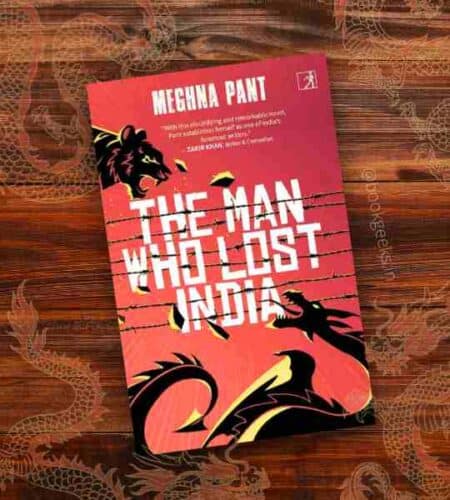RATING: 3.5/5
Genre: Dystopian, Futuristic, Drama
Themes: India-China War
Set in the year 2032, this mind-boggling, politically charged novel about pillage and plunder; power and control, and dominance and rivalry in a surprisingly not-so-far future, centers around the affluent businessman Seth and his family who are residents of a small town in Punjab named Lalbag.
Seth’s family comprises of his wife Kamala, son Vakil, and daughter Ida. He is the richest man in Lalbag who lives in a bungalow in the Royal Mason residential compound called The White Taj. He owns most of the factories that are located west of Lalbag, as well as runs a successful mobile business with multiple stores.
The Man Who Lost India opens on a rather calm Sunday afternoon, that is ordinarily meant to be spent leisurely with Seth and his kids flying kites. However, the air feels heavy as the headlines make ripples through the airwaves. The danger of a war with China looms large and seems just around the corner.
The headlines declare the fall of the Rohtang Pass in a surprise Chinese assault, which is about to break the misconception of Seth that wars don’t affect and do not make any difference to well-off individuals like him.
Soon, explosions are heard in the neighboring town of Kharbag and the very next minute, their neighbor’s home is ransacked. What follows is unending chaos backed by The Doctrine of Absolute Territorial Sovereignty that is promoted by Chinese political strategists.
From border assaults to incursions, and then absolute invasion, capture and strategic overtake, the plot ensues with a moderate pace in creating an atmosphere of what may be called nationwide political turmoil. This results in angst and despair about a greater menace that may unfold in the forthcoming days of Indo-China regional politics.
It seems far from being just a war about attacking Indian land but a technological war with complete control over Indian social media handles, which is to some extent followed by biological warfare. All of this gets mixed to create what is termed as New China out of the invaded Indian soil.
New China controls most of the administrative, economic, and political aspects of Lalbag which affects residents like Seth and creates an unprecedented demographic shift.
In this rather serious plot full of unexpected twists and turns, there is the element of the story within the story in the form of the love story of Ida and her lover Manu, despite the fact that Ida is to tie the knot with someone else in a marriage of convenience.
Ida and Manu’s hush-hush love story may not be openly known to the society in post-war New China, but their passions run wild, as do new regulations in this whole new world altogether. These regulations are all about birth control and the threat of Bollywood movies that tend to arouse Indian sentiments, which can create mass movements and anti-establishment gatherings.
Additionally, in this microcosm of Indians living under Chinese rule, there is the issue of internal politics in the form of business rivalries that affect the lives of Seth and those related to him. Intertwined with the family drama is the fate of a nation struck with innumerable wars.
Apart from these, there is the problem of individual histories marked by the power dynamics between the different characters, which are all coalesced together.
Even though so many things are going on at the same time, there is never a sense of collision of ideas, or the coaxing together of irrelevant and disconnected bits of information. It is this seamless blending of thoughts, views, ideas, and opinions that creates an action-packed socio-political saga with memorable characters, who help to carry forward the narrative while giving it depth and dimension.
In The Man Who Lost India, characterization is critical and crucial to the development of the story and the flow of the events that follow one after the other, at a more or less moderate pace. The characters are well-built, and rounded and convey their ideas through short, crisp dialogues. There are also some foil characters who receive enough space and time to help the major characters grow.
Their emotions, passions, resilience, and fight for basic human rights are depicted with sensitivity and maturity. They are cast with a love for their land and serve the purpose of not only adding to the flow of the narrative but also depicting the myriad aspects of the plot and its many-sided possibilities.
These possibilities arise in terms of political, social, and economic implications for Seth, Lalbag, New China, and the region as a whole.
There is an eye for detail and a sense of maturity in dealing with such an intense topic that makes the writing style impeccably effortless.
The thoughts, and scenes or situations created, are an outcome of a highly imaginative mind that makes Shiva, his power, and his aura as a force that runs parallel to the ensuing events of the novel, a significant and timeless character.
Every chapter title is unique and hints at what is to follow in the later chapters. There is a good blend of poetry, shlokas, and quotations. All these are interspersed through the narrative to describe the assault on land, heritage, and culture, making for a lengthy, but unique reading experience.
The Man Who Lost India ends on a note that marks the end of Kali Yuga and the start of Satya Yuga. With a beautifully done book cover, this book is a must-read for lovers of political sagas or dystopian fiction, and definitely, those who think that women cannot ace serious writing.
Can’t wait to read it? Buy your copy of The Man Who Lost India using the link below.
